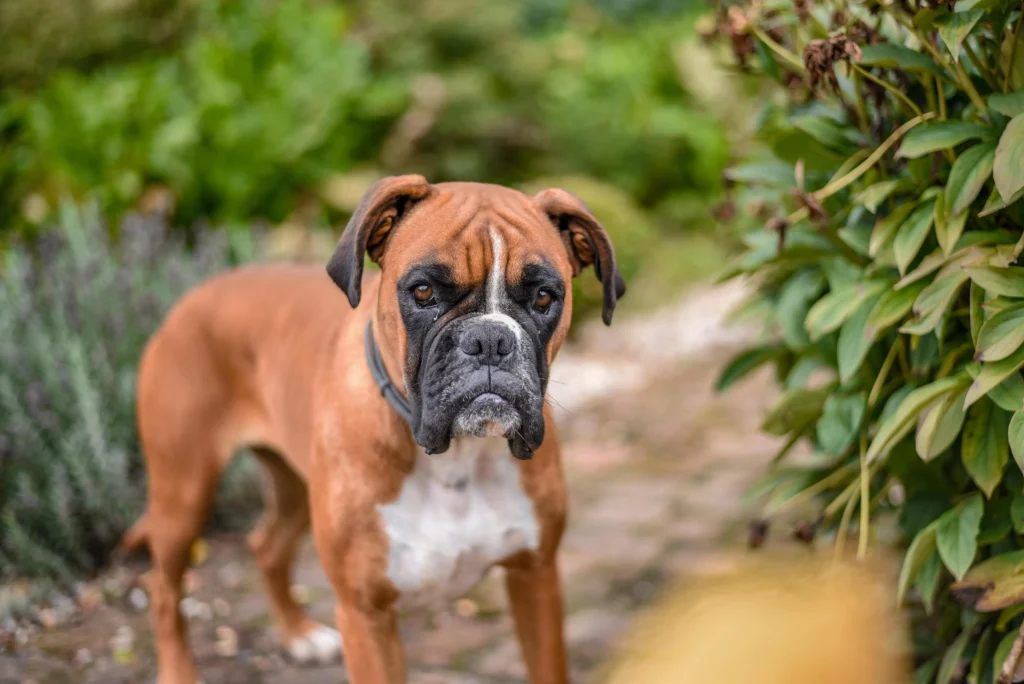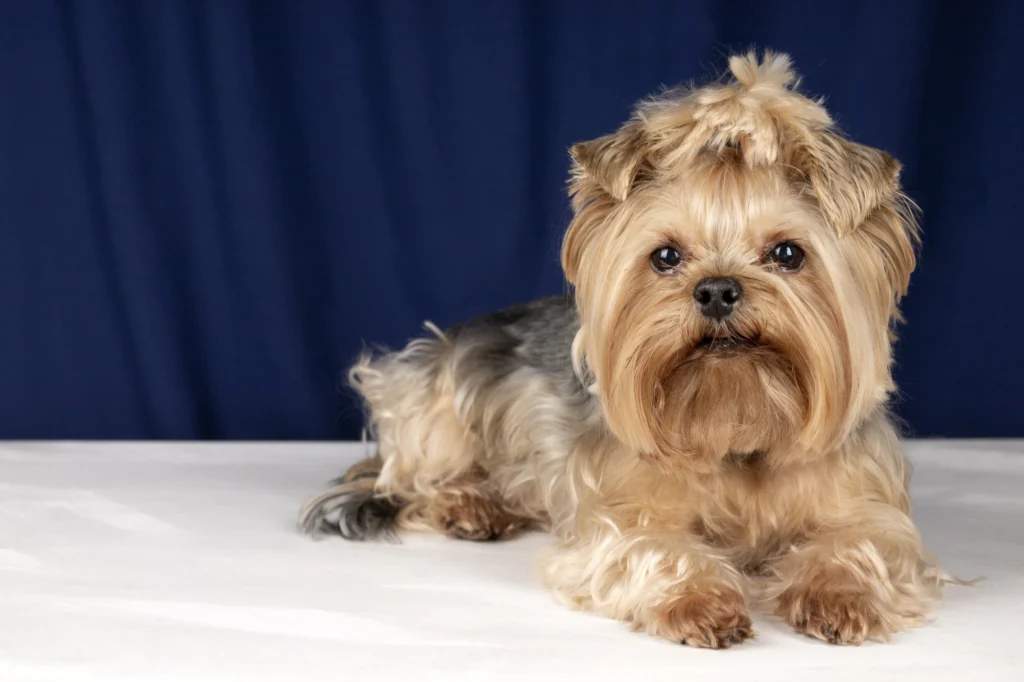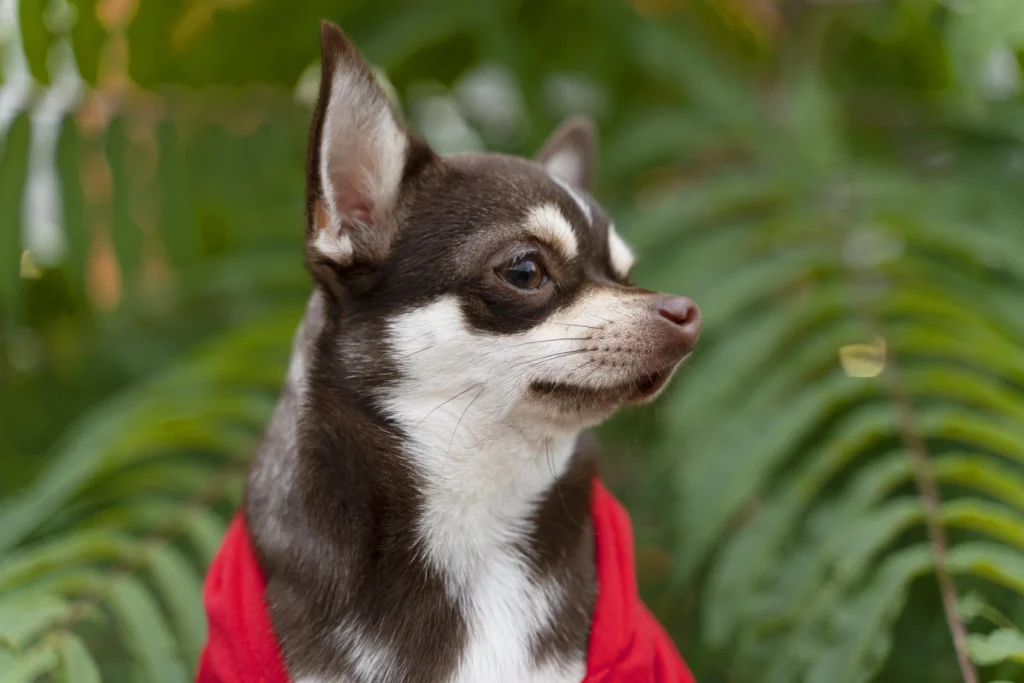Few of the many dogs that have trodden over the feet of mankind through centuries of civilization can compare to the magnificence, devotion, and silent pride of the English Mastiff. Stated to be the Gentle Guardian, this giant breed can be viewed as an ideal combination of power and calmness, a fearsome creature that has a heart as big as it is. When a person is in front of an English Mastiff, one cannot help but feel awe; its presence alone is a command that cannot be disobeyed, but the calm, loving look of the beast makes the fear melt away immediately.
The English Mastiff is considered to be one of the large dog breeds in the world, with a noble lineage dating back thousands of years. It has since evolved into a loving family member and a protector after it was used as a war dog and a protector of estates. There is a spirit inside its muscular body and its dominant posture; it is not aggressive but loyal, patient, and loving.
We will discuss the history of the English Mastiff, its personality, and its needs, as well as health-related factors and the life you are bound to experience with such a pet in this ultimate guide. As a dog lover or a future owner, there is no better way to be in touch with this breed and be in a position to know why the English Mastiff has been one of the most popular gentle giants in the history of dogs.
History and Origin of the English MastiffD
The English Mastiff originated thousands of years ago as an offspring of the primitive molosser dogs that were in Mesopotamia and Egypt. These mastiff-like dogs in their early form were valued due to their strength and bravery and were allowed to work as war dogs, and they guarded homes and animals. Another carving and writing dated around 3000 BC shows large, short-muzzled dogs escorting warriors to war or even protecting royal palaces.
As Europeans began to spread trade and conquests, these dogs began their way into the British Isles, where they were refined and bred into the modern English Mastiff. The documentary tells of big British dogs that fought with the soldiers in Roman times and secured fortresses. Their courage was reported by the historian himself, Julius Caesar, when he invaded Britain in 55 BC and brought some of them to Rome as presents.
The English Mastiff had become a representative of power and faithfulness in the English families by the Middle Ages. They were used to protect estates and castles, keep livestock safe against wolves and bears, and as companions of noble families. Their boldness on the battlefield and peaceful character in their homes were the factors that made them highly appreciated in Europe.
Nevertheless, the breed was on the verge of extinction in both World Wars as a result of food scarcity and poverty. Luckily, there were committed breeders, especially breeders in the United States and Canada, who strove to restore the lineage post World War II. The breeding and preservation of the English Mastiff helped it to be a family pet and guardian again.
Even now, the English Mastiff still represents undying devotion and guardian elegance, an embodiment of ancient times and newfound friendship.
Physical Characteristics: The Grandiose Performance
The size of the English Mastiff is nothing to be proud of. It is called the heaviest dog breed in the world most of the time, and it has a mix of rawness and calm composure about itself. Males are normally 30 inches tall at the shoulder and may weigh 160 to 230 pounds (73-104 kg), and females measure 120 to 170 pounds (54-77 kg). Some outstanding males have weighed more than 250 pounds.
The general form of the breed is a rectangle, with a deep chest, broad shoulders, and straight and strong legs that carry the heavy weight of the breed. One of the distinctive features of the Mastiff is its head: it is huge, it is square, and it has a short muzzle and a black mask on it. The dark and deep eyes and wrinkled forehead make the dog look wise and even contemplative.
Their coat is short, smooth, and thick, providing humble protection against the elements. Colors are usually fawn, apricot, and brindle, each having the typical black muzzle and ears. The Mastiff can move gracefully with great agility despite its large body, especially through its slow and steady gait, which indicates its relaxed temperament and self-assured demeanor.
All elements of the English Mastiff’s appearance, such as muscular structure and expressive eyes, reveal the history of a breed engineered to be both protective and entertaining.
Temperament and Personality: The Compassionate Protector Of
The temper is as great as the size of the English Mastiff. One of the most common ways of describing this breed is that it is dignified, affectionate, and protective, thus the meaning of a gentle giant. It may seem the most frightening, but its real image is peaceful, tolerant, and affectionate.
Mastiffs are very faithful to the family. When they get attached to their masters, they are obedient to the end. They have been known to take a close attachment, especially to children, and tend to become the silent protector, patient, tolerant, and watchful. Placing oneself in between the family members and perceived dangers is not an unusual act that a Mastiff instinctively tends to engage in as a living protection.
English Mastiffs are not aggressive dogs, even though they have the instinct to protect each other. They use the strategy of prevention; they are well known to scare back intruders by their mere presence. They can only be defensive when they feel that they are in real danger.
The other characteristic of the breed is intelligence, which is accompanied by a dose of independent thinking. Mastiffs are intelligent pupils, and they are sensitive to kind, retracted training as opposed to vicious correction. This makes early socialization imperative because of their size and power so that they can grow up to be confident and well-mannered adults.
They do not have a reputation of being highly energetic, but they walk daily and engage in moderate exercise as part of ensuring that they remain healthy. They like to relax and pass away time with their families more than spending their time watching others, so they prefer to sit somewhere on the floor or watch over the people sitting in their favorite position.
Most importantly, the character of the English Mastiff represents an ideal combination of power, faithfulness, and gentleness traits, and makes them one of the most popular family protectors in the world of dogs.
Caring for an English Mastiff
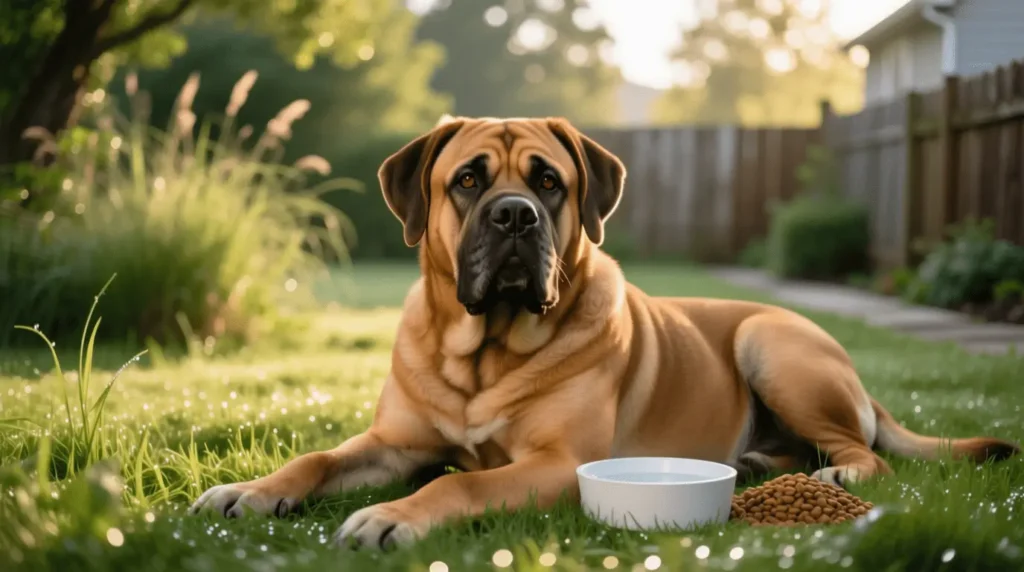
As a privilege, it is also a responsibility to own an English Mastiff. They are very large and have certain requirements, which imply that the potential owners should be ready to make a lifelong commitment and treat them properly.
Diet and Nutrition
An English Mastiff has to be fed cautiously. Blistering rapid puppy development may cause problems with joints and bones, and thus, a large puppy formula is essential. Excess protein consumption or overfeeding may lead to unnatural growth acceleration that may cause hip and elbow dysplasia.
Adult Mastiffs are supposed to take two to three smaller meals per day instead of one large meal to reduce the chances of gastric torsion (bloat), which is a fatal illness that is characteristic of deep-chested breeds. They should take quality protein, moderate fats, and controlled calories so that they can keep their weight under control. Frequent veterinary instructions are essential to maintain the amount of portions and nutritional ratios.
Exercise and Space Needs
They are also peaceful dogs, but Mastiffs should exercise regularly to stay in shape and avoid obesity. Light play and a few walks, moderate ones, should be enough every day. Do not subject them to heavy exercise in their growth or in hot seasons because they are likely to overheat since they are so large.
Due to their space needs, Mastiffs would be fitting in areas with big yards or open spaces. They also easily adjust to living in the house, provided they are not kept in one spot and they have ample space to move around freely.
Grooming and Hygiene
An English Mastiff is not very complicated to groom because it has a short coat. Weekly brushing is useful in controlling shedding and making the coat shiny. Their wrinkles and jowls, however, need to be washed on a daily basis in case of bacterial accumulation or irritation. Good hygiene should include routine ear exams, nail clipping, and dental treatment.
Mastiffs also drool, especially when they eat or drink, and hence the owners ought to keep towels to clean them up easily. Although it is a minor inconvenience that a dog may drool, the vast majority of Mastiff owners do not regard it as anything more than an adorable habit of their giant.
Health and Lifespan
The English Mastiff also leads a shorter life, like other giant breeds, with an average lifespan of between 6 and 10 years. They should be closely monitored in order to maintain a good life.
The frequent health problems are:
- Hip Dysplasia and Elbow Dysplasia: This is a condition of developmental joint disease that leads to pain and restriction of movement.
- Bloat (Gastric Dilatation-Volvulus): A life-threatening complication in which the stomach turns inside out, permanently obstructing blood flow.
- Heart Disease: This is like dilated cardiomyopathy, which is more prevalent in large breeds.
- Eye Problems: These include entropion and ectropion (inward/outward turning eyelids).
- Joint and Bone Stress: This may be found in overweight dogs or dogs that do not receive proper exercise during their growth.
Normal veterinary checkups, weight management, and moderate exercise can go a long way in enhancing life span and comfort. Mastiffs also enjoy orthopedic beds, joint supplements, and a large breed-specific diet.
Training and Socialization
English Mastiff training takes time, and there should be consistency and positive reinforcement. Their wit enables them to master instructions without hard work, yet their independent nature may be seen as obstinacy. Inhumane or extreme measures will only backfire because Mastiffs are sensitive, and they would turn unresponsive in case they are not treated fairly.
Training should begin at a young age, with rudimentary obedience teaching including sit, stay, and come. It is also important to socialize them early in life: they need to be exposed to people, pets, and places when they are still puppies to avoid becoming fearful or protective in adulthood.
They are too big to be taught without leash training; a simple game of tag on a Mastiff could be a force. After regular training, they grow up and become docile, calm companions who are dependable and gentle to all members of the home.
Mastiff as a Family Dog: Pros and Cons
The Mastiff in the Modern Home
There are not many breeds that represent the concept of a kindly guardian like the Mastiff. However gigantic in size and muscular in construction, the heart of this dog is so tender that it can be regarded as one of the most faithful and loving members of the family that a family can ever have. The mastiff is a breed that is well-suited to households where there is love, serene leadership, and space. It is patient in nature, and its power is silent, and thus it can easily adapt to family life when properly guided and taken care of.
Nevertheless, it is not as unique to live with a Mastiff as it would be to keep an average-sized dog. Their huge sizes, special temper, and medical requirements present a different category of obligations. Families that are planning to keep this noble breed need to know the benefits as well as the challenges that may come along their way to have a peaceful relationship.
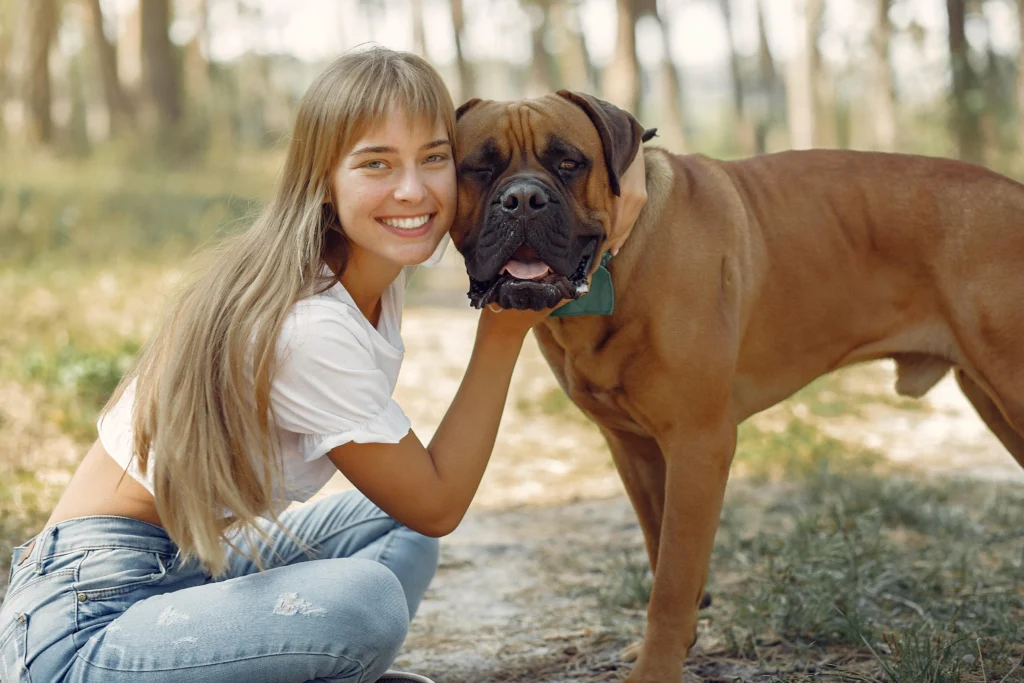
The Pros of Owning a Mastiff
1. A Loyal and Protective Guardian
The guarding instinct of the Mastiff has a long history. This breed developed into an estate protector and war dog and, consequently, has an inbuilt feeling of responsibility towards the family. In contrast to ferocious guard dogs, namely the Mastiff, is rational and controlled in his/her approach to protection. It does not yell and bark unnecessarily or rush at the unwanted people without reason, but by its very presence and fixed stare, it can keep away trespassers.
The Mastiff is also protective in a family environment and thus offers peace of mind. It naturally stands between its loved ones and what it perceives as danger, and it provides a feeling of security that is seldom possible with other breeds. A Mastiff is a perfect home guard to the family who lives in the suburbs or countryside because it provides peaceful guarding.
2. Superbly Kind-hearted with Children
It may be that the gentleness of the Mastiff towards children is the most charming trait of this animal. This breed is often referred to as a gentle giant, and it has a sense of knowing when to be delicate and innocent. None of the young children is known to play roughly and noisily without being remarkably patient with their Mastiffs.
Most Mastiffs have the instinct of parental protectiveness, and so, although they will always need supervision because of their enormous size, they possess a nurturing instinct. They like lying down with children, trailing the children in and out of rooms, or guarding them in the playground. This characteristic makes the Mastiff one of the most reliable large breeds within the family setup.
3. Calm and Even-Tempered Indoors
Mastiffs are very peaceful, even in spite of their powerful physique. They do not enjoy loud company; they usually like relaxing with their family more than running around. As it grows up, the energy levels of the Mastiff also go down to a significant extent, and hence the breed is suitable in an environment where peace and order are the main priorities.
This is a calming nature and a gift to the family who desires a large, protective dog but does not require hyperactivity like some breeds of working or herding dogs. Inside the home, a Mastiff acts in a dignified and calm manner, and it will tend to sleep near its owners as a quiet guardian.
4. Deep Emotional Bonds and Affection
The Mastiff’s love runs deep. These are emotionally intelligent dogs that establish deep and enduring bonds with their family members. They are in need of human companionship and frequently lean softly against their masters as a way of expressing love. A lot of owners refer to their Mastiffs as sensitive individuals, understanding of the moods, comforting in case of sadness, and loyal at all times.
The Mastiff is not only a guardian but also a genuine companion of the family because of this close attachment. To people who want to see a dog that can provide them with emotional comfort and physical protection, not many breeds can compare to such devotion.
5. Low Barking and Non-Aggressive Demeanor
Mastiffs are not as responsive to all sounds and movements as other breeds are, but they respond intentionally. They also have the tendency to only bark when something really matters to them, and hence keep the house very peaceful. This is coupled with silent assurance and reserved vigilance, of which they are such reliable family guardians.
The Cons of Owning a Mastiff
1. Immense Size and Space Requirements
The size of the Mastiff is the most evident issue of its ownership. Male adults may weigh above 200 pounds, and even their female counterparts are much bigger than the majority of dogs. Their size demands that they have plenty of room to stretch out in and, as far as possible, a large yard at home or at least a large open area where they can exercise their size.
Mastiffs do not feel comfortable or frustrated in smaller houses or apartments. Their tails are capable of sweeping away things on tables easily, and a single step back can run over a small child or an aged member of the family. The families should be ready to make adjustments to accommodate this giant.
2. High Cost of Ownership
The bigger it is, the bigger the cost. Owning a Mastiff is more expensive in terms of finances than other smaller breeds. They can consume a lot of food by themselves, with adult Mastiffs consuming a few cups of high-quality dog food per day.
Besides the food, veterinary services are also costly because of their weight and being prone to health complications associated with their size, including hip dysplasia, bloat, and joint disorders. There is a great need to use medications, supplements, and even grooming supplies in larger amounts. Future owners need to spend wisely so that they are able to satisfy the lifelong needs of the breed.
3. Shorter Lifespan
The comparatively short life of a Mastiff is one of the most heartbreaking facts when it comes to having a Mastiff. Mastiffs have a lifespan of 610 years on average. This may be hard to digest for families that have strong emotional bonds with their pets.
However, with good nutrition, weight management, regular veterinary check-ups, etc., their lives can be prolonged, and their quality of life improved. The owners should be prepared emotionally to accept the bitter fact that such a big heart does not always beat as long as smaller breeds.
4. Stubbornness and Slow Maturity
Mastiffs are not stupid dogs, as they can be strong-willed. The reason is that they are independent thinkers and, therefore, will be willing to follow commands at their own convenience. Training takes time, regularity, and positive reinforcement since cruel training may destroy their confidence.
Particularly, puppies are obstinate and slower to mature mentally. The owners have to start the socialization process early and strengthen good behavior. It is through consistent training that the Mastiffs become tame and strong-willed adults, and without discipline in training, inexperienced or impulsive owners have a hard time keeping them.
5. Health and Mobility Concerns
Mastiffs’ breed is susceptible to various health problems due to size and structure. The most frequent ones include joint stress, hip and elbow dysplasia, and bloat. Their weight also strains their bones and ligaments, especially when they are given an opportunity to run too much during their growing period.
They are also affected by the warmth, and they need shaded or air-conditioned rooms during the hot weather. Their lifestyle is sedentary, and unless their diet and activity are carefully regulated, obesity can easily develop.
Balancing the Pros and Cons
Deciding to have a Mastiff in a family should not be an impulse move. As much as they make perfect companions because of their reservedness, love, and devotion, they also require dedication, space, and tolerance.
Families who value quiet companionship and can afford a big breed find the Mastiff to be an unconditional love and protection, which will never let them down. Nevertheless, other breeds can be more appropriate to the lifestyle of people living in smaller areas or wanting their dog to be more active and longer-lived.
The secret of a successful relationship with a Mastiff is in their physical needs and emotional care, their independence and systematic training, and their enormous bodies and tender love.
Once these elements are unified, the outcome can only be described as something exceptional: a reliable protector, a loving friend, and an undemanding guardian whose presence can only be described as filling the house with even more than safety and warmth.
Overview of Other Mastiff Breeds
The word “mastiff” cannot be used to describe, but only to denote a family of large and powerful dogs that have a common ancestry. The initial breeds were created in different parts of the world to be used as guards, hunters, and companions. Though they do not look alike or have the same characteristics, all the Mastiff-type dogs have the same essence; they are fearless, loyal, and highly devoted to their families.
A review of the most popular Mastiff breeds and their uniqueness is provided below.
1. Bullmastiff: The Gamekeeper Protectionist.
The Bullmastiff can be traced back to 19th-century England, where they were formed as a result of a hybrid between the English Mastiff and the Bulldog. Its initial intention was to help gamekeepers scare away poachers of large estates. The breed got the size and strength of the Mastiff as well as the agility and willpower of the Bulldog, which created a dog that can easily follow and pin down an intruder without being overly aggressive.
The primary qualities of the modern Bullmastiff are loyal, confident, and affectionate family companions. They are very much smaller than English Mastiffs; they are usually between 100 and 130 pounds and are equally protective. They are great house protectors for experienced house owners due to their short coats, expressive faces, and calmness.
2. Neapolitan Mastiff: The Wrinkled Guardian of Italy
The Neapolitan Mastiff (or Mastino Napoletano) was descended from the ancient Roman war dogs and is immediately identifiable by its huge size and grotesque skin folds. It was reintroduced in southern Italy, where it was used as a home and estate protector.
In spite of the threatening appearance, including loose skin, jowling cheeks, and a slow, lumbering walk, the Neapolitan Mastiff is famous due to the faithfulness and loving nature of its temperament to its family. It is, however, inherently suspicious of newcomers and has to be trained and early socialized.
The slowness of the movements and the keenness of the eyes of the breed are a sign of centuries of guarding instinct. Due to their size and independent characters, Neapolitan Mastiffs are only suitable for mature owners who know big and protective types of breeds.
3. Tibetan Mastiff: The Ancient Sentinel of the Himalayas
The Tibetan Mastiff is by far one of the most enigmatic and ancient of all the breeds of Mastiffs, as it was created thousands of years ago in the Himalayan mountains. Nomadic herders and monks traditionally used it to protect the flocks and monasteries against intruders, wolves, and leopards.
The Tibetan Mastiff is a cold-weather and rough-ground dog with its thick double coat, bushy tail, and lion-like mane. It is a free-thinking, clever, and powerful dog, which has been termed as cat-like in making decisions.
The Tibetan Mastiff, unlike the easy-going English Mastiff, is indifferent to strangers and prefers to be close to one or two of his or her relatives. Although affectionate and protective, it needs strong leadership and room to move about. It is a wonderful companion, royal, enigmatic, and very faithful to true owners.
4. French Mastiff (Dogue de Bordeaux): The Brave House Pet
The Dogue de Bordeaux, also known as the French Mastiff, is among the oldest and most unique breeds of dogs in France. The Dogue de Bordeaux is known to possess a huge head, muscular physique, and a face that is full of expressions, which integrate strength and a disposition that is quite tender.
This breed used to pull carts, guard estates, and help butchers in history, and its functions required strength and intellectual abilities. The Dogue de Bordeaux is a caring and loving member of the family today.
Though it is small compared to the English Mastiff, it is livelier and more demanding and ought to be trained in obedience early and guided regularly. This breed became known to the rest of the world thanks to the movie Turner and Hooch (1989), which demonstrated its adorable and serious nature.
5. Spanish Mastiff: The Shepherd Dog of the Flocks
The Spanish Mastiff was a reproduction of the dog that lived in the wilderness of the Spanish land, protecting the herd of sheep and animals against wolves and bears. This breed is characterized by its calm nature, huge size, and deep and booming bark. Males usually weigh over 200 pounds, making them one of the heaviest members of the Mastiff family.
The Spanish Mastiffs are docile, quiet, and smart, yet they are so huge. They are very close to their family and herd and are fearless when danger is involved, but will hardly show aggression without a valid reason. They are good working dogs because of their independence, which can also make them slow to react to commands, a trait that the centuries-old experience of being independent guardians has instilled in them.
6. Other Regional Mastiff Breeds
Besides the large lines of Mastiffs, there were also several regional types whose characteristics are different:
- Pyrenean Mastiff (Spain)—The Pyrenean Mastiff was raised as a herd dog, and it is considered to have a calm and agreeable personality.
- Brazilian Mastiff (Fila Brasileiro) – A courageous protector and also a hunter, the breed is well known because of its loyalty and instinctive distrust of unknown persons.
- South African Mastiff (Boerboel)—It was a breed created as a farm guard; it is strong-willed, confident, and loving to its family.
These local differences also show how flexible Mastiff-type dogs were; they adapted to the surroundings and the task they were to perform.
Conclusion: The Legacy of the Gentle Guardian
The English Mastiff is a monument to moderation, great power, and great love, and a primitive origin mixed with new devotion. Through the battlefields of ancient times and through the living rooms of modern times, this breed has stayed true to its mission, which is protecting, comforting, and loving unconditionally.
The mastiff family represents a wide but harmonized group of breeds, each of which is a representation of the cultural, environmental, and historical factors in the country of origin. Every Mastiff breed is filled with the same flair of nobility, silent force, and unblinking loyalty: the stately English Mastiff, the hardy Tibetan guardian, and the loyal Dogue de Bordeaux, all of which carry the same aura of nobility.
As dogs of ancient times, which fought in wars or are today used as family guards, Mastiffs have gained respect and recognition as some of the most revered and treasured breeds in the history of dogs.
Owning an English Mastiff is a process of shared respect and trust. They are not ordinary dogs but good companions that make any place they live in peaceful and secure. To those families that are willing to offer the care, training, and love they rightfully deserve, the English Mastiff has something to sell that can never be replaced with money: a guardian of hearts, a guardian of homes, and a friend that will never quit loving you.
Ultimately, the English Mastiff is not merely a breed; it is an embodiment of dignity, courage, and compassion, actually making it the Gentle Guardian.
